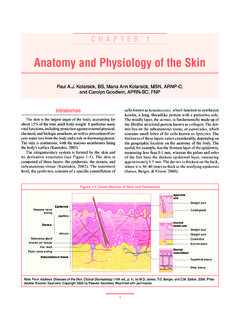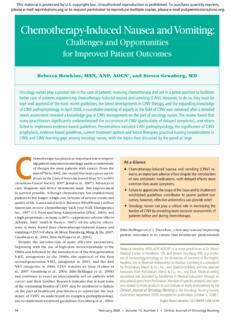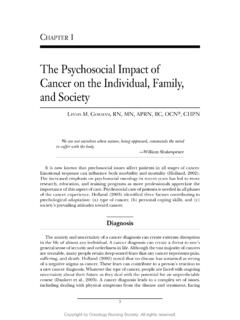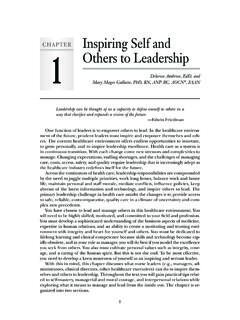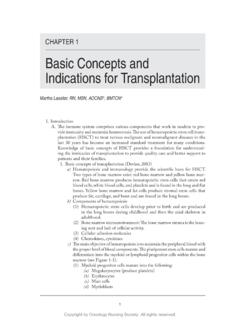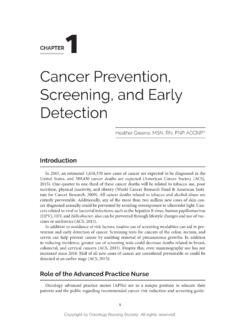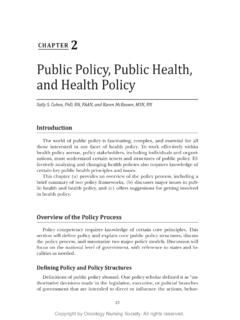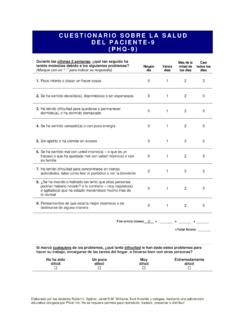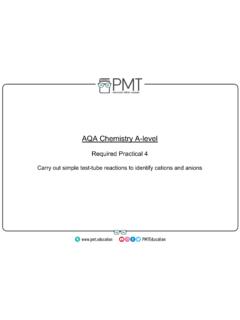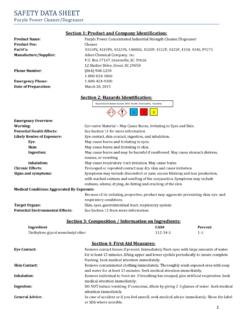Transcription of Personal Protective Equipment for Use With Hazardous Drugs ...
1 The following list includes examples of gloves meeting ASTM D6978 standards, according to testing results and information from the manufacturer. The list is limited by space considerations and is not all-inclusive. Inclusion of a product or manufacturer does not imply endorsement by ONS or any other Professional, 2014 purple nitrile Product Code:KC500 Ansel, Nitra-Tex Product Code:6034010/6034014 Covidien, Latex GlovesProduct Code:CT0191 CT0194 Two pairs of chemotherapy-tested gloves should be worn for all HD-handling activities. Change gloves every 30 minutes or immediately if damaged or knowingly contaminated. Gloves must be disposable and powder-free; made from nitrile , neoprene, or latex; and have a cuff long enough to cover the sleeves of the gown. Thickness will vary according to glove material. With chemotherapy preparation, use sterile gloves as the outer glove. (ASHP, 2006; Connor, 1999; Gonzalo-Garijo et al.)
2 , 2012; NIOSH, 2008; Wallemacq, 2006)Chemotherapy-tested glovesThe most recent standard for HD glove testing from the ASTM is D6978-05, which replaced the older (1999) standard of ASTM F739. The following are examples of products that meet the most recent ASTM D6978 standards. Glove testing results are available from the manufacturer and printed on the box. Gloves are tested for permeability by specific chemotherapy Drugs . Ensure that the selected gloves have been tested against the types of chemotherapy used in practice. (Polovich, Power, Massoomi, & Connor, 2015) Personal Protective Equipment for Use With Hazardous DrugsDeveloped in 2016 through a collaboration of the American Society of Clinical Oncology, American Society of Health System Pharmacists, Association of Community Cancer Centers, Association of Pediatric Hematology/Oncology Nurses, Hematology/Oncology Pharmacy Association, and the Oncology Nursing SocietyReceiving and unpacking HDsReconstituting, admixing, and manipulating HDs within PECA dministering any HD (single pair needed to administer intact, unit dose-packaged, oral chemotherapy doses)
3 Spill cleanupPersonal Protective Equipment for Use With Hazardous DrugsDeveloped in 2016 through a collaboration of the American Society of Clinical Oncology, American Society of Health System Pharmacists, Association of Community Cancer Centers, Association of Pediatric Hematology/Oncology Nurses, Hematology/Oncology Pharmacy Association, and the Oncology Nursing SocietyWhen selecting gloves for practice, it is important to ensure that the product is functional and effective. Involve staff members in the product decision. Consider ordering samples of several types of chemotherapy-tested gloves, then have staff members trial the gloves in the clinical setting. Evaluate for quality, flexibility, durability, and other indicators identified by those using the gloves. Include price in the infusionsDisposal of HDsSterile gloves for operating room use, sterile procedures, and sterile preparationRoutine cleaningTwo pairs of chemotherapy-tested gloves are recommended for use with the following activities (unless noted):(NIOSH, 2008, 2014)Selecting Gloves for PracticeHandling excretaPersonal Protective Equipment for Use With Hazardous DrugsDeveloped in 2016 through a collaboration of the American Society of Clinical Oncology, American Society of Health System Pharmacists, Association of Community Cancer Centers, Association of Pediatric Hematology/Oncology Nurses, Hematology/Oncology Pharmacy Association, and the Oncology Nursing SocietyGowns used when handling chemotherapy are disposable and made of polyethylene-coated polypropylene or other laminate, lint-free, and low-permeability fabric.
4 The gown has a solid front with long sleeves and tight/closed elastic or knit cuffs. No seams or closures are present on the front of the gown that could permit Drugs to pass through. Gowns are designed for a single use and should not be re-applied after removal. (NIOSH, 2004a, 2008; USP, 2016)Chemotherapy-tested gownsAlthough no standard exists for testing gowns for HD permeability, some manufacturers have tested their product with several antineoplastic agents. Standards used in glove testing have been applied to test gown permeability and are available by request fromthe manufacturer. (Harrison & Kloos, 1999; Polovich et al., 2015; Polovich, 2011; Thompson, 2012)The following list includes examples of gowns meeting NIOSH recommendations, according to testing results and information from the manufacturer. The list is limited by space considerations and is not all-inclusive. Inclusion of a product or manufacturer does not imply endorsement by ONS or any other gowns for practiceAs with glove selection, it is important to ensure that gowns are functional and effective.
5 Encourage staff members to trial products that meet the NIOSH recommendations and practice needs. Gown UseChemotherapy gowns must be worn during the following: Compounding (no longer than 3 hours) Administration Disconnection Disposal of HDs Spill clean-up Handling excreta (NIOSH, 2008, 2014)Cardinal Health, 2016 Poly-coated SMS chemotherapy gownProduct Code:8200CG 8201 CGCovidien, Poly-Coated GownProduct Code:CT5502 CT5505 Halyard, 2015 Procedure Gown for Use With Chemotherapy DrugsProduct Code:69606/37284 Developed in 2016 through a collaboration of the American Society of Clinical Oncology, American Society of Health System Pharmacists, Association of Community Cancer Centers, Association of Pediatric Hematology/Oncology Nurses, Hematology/Oncology Pharmacy Association, and the Oncology Nursing SocietyPersonal Protective Equipment for Use With Hazardous DrugsPersonal Protective Equipment for Use With Hazardous DrugsDeveloped in 2016 through a collaboration of the American Society of Clinical Oncology, American Society of Health System Pharmacists, Association of Community Cancer Centers, Association of Pediatric Hematology/Oncology Nurses, Hematology/Oncology Pharmacy Association, and the Oncology Nursing SocietyRespiratory ProtectionRespiratory protection is needed when cleaning HD spills or when there is a risk of exposure to HD aerosols or vapors through inhalation.
6 Protection should be worn with intravesical administration or HIPEC. Respiratory protection should be selected based on the identified hazard. Fit-tested N-95 or N-100 particle masks are sufficient for most activities. For cleaning large spills, chemical cartridge-type respirators should be used. A standard surgical mask provides no protection and is not recommended. (Eisenberg, 2009; NIOSH, 2004b, 2006, 2015; USP, 2016)ActivityType of ProtectionAirborne particles Intravesical administration Spills that can be contained within a spill kitFit-tested, NIOSH-certified N95 or more Protective respiratorGasses and vapors Unpacking HDs that are not contained in plastic HD spills larger than what can be contained in a spill kit Deactivating, decontaminating, and cleaning C-PECE lastometric half-mask with a multi-gas cartridge and P100-filter. Replace filters when damaged, soiled or causing increased breathing resistance (NIOSH, 2005).
7 Developed in 2016 through a collaboration of the American Society of Clinical Oncology, American Society of Health System Pharmacists, Association of Community Cancer Centers, Association of Pediatric Hematology/Oncology Nurses, Hematology/Oncology Pharmacy Association, and the Oncology Nursing SocietyPersonal Protective Equipment for Use With Hazardous DrugsEye ProtectionUse:Potential for splashing, such as administration in the operating room, intravesicularadministration, working above eye level, or when cleaning spillsSection:Goggles are needed to provide protection against splashing to the eyes. Eyeglasses or safety glasses with side shields are not sufficient protection (NIOSH, 2008).Face ProtectionUse:Face shields used to protect against splashingSection:Use face shield in combination with goggles to provide full protection against splashing to the eyes and and Hair CoverUse:Used for protection from HD particulate or microbial contamination in clean rooms and other sensitive areas (NIOSH, 2008)Section:Constructed of coated materialsShoe CoversUse:Wear shoe covers when compounding HDs.
8 Remove shoe covers when exiting the compounding room (NIOSH, 2008). Wear a second pair of shoe covers when entering the compounding area (USP, 2016).Sleeve CoversUse:Provide protection from HD residue on arms that come in contact with surfaces of the BSC (NIOSH, 2008 Section:Select disposable sleeve covers made of polyethylene-coated polypropylene or other laminate American Society of Health-System Pharmacists; ASTM American Society for Testing and Materials; BSC biologic safety cabinet; C-PEC containment primary engineering control; HD Hazardous drug; HIPEC hyperthermic intraperitoneal chemotherapy; NIOSH National Institute for Occupational Safety and Health; ONS Oncology Nursing Society; PEC primary engineering control; PPE Personal Protective Equipment ; USP Pharmacopeial ConventionPersonal Protective Equipment for Use With Hazardous DrugsDeveloped in 2016 through a collaboration of the American Society of Clinical Oncology, American Society of Health System Pharmacists, Association of Community Cancer Centers, Association of Pediatric Hematology/Oncology Nurses, Hematology/Oncology Pharmacy Association, and the Oncology Nursing SocietyAnsell.)
9 ( ). Chemical testing results. Iselin, NJ: , (1999). Permeability of nitrile , rubber, latex, polyurethane gloves to 18 neoplastic Drugs . American Journal of Health-System Pharmacy, 56, 450 Health. (2016). Controlling infection and your costs: Infection control apparel. Retrieved from ( ). Chemotherapy glove testing. Mansfield, MA: ( ). Chemotherapy gown permeation testing: ChemoPlus poly-coated impervious gowns. Mansfield, MA: , S. (2009). Safe handling and administration of antineoplastic chemotherapy. Journal of Infusion Nursing, 32, 23 32. , , Caballero, , Gil-Micharet, , Moneo, I., P rez-Calder n, R., & Garc a-Borruel, L. (2012). Hypersensitivity reactions due to nitrile gloves. Journal of Allergy and Clinical Immunology, 129, 562 (2015). Protective apparel catalog. Retrieved from , & Kloos, (1999). Penetration and splash protection of six disposable gown materials against fifteen antineoplastic Drugs .
10 Journal of Oncology Pharmacy Practice, 5(2), 61 66 Kimberly-Clark Professional. (2014). Chemotherapy drug resistance ASTM D6978-05. Retrieved from Institute for Occupational Safety and Health. (2004a). NIOSH alert: Preventing occupational exposures to antineoplastic and other Hazardous Drugs in health care settings. Retrieved from Institute for Occupational Safety and Health. (2004b). NIOSH respirator selection logic. Retrieved from Institute for Occupational Safety and Health. (2008). Personal Protective Equipment for health care workers who work with Hazardous Drugs . Retrieved from Institute of Occupational Safety and Health. (2014). NIOSH list of antineoplastic and other Hazardous Drugs in healthcare settings, 2014. Retrieved from Institute for Occupational Safety and Health. (2015). Respirator trusted-source information. Retrieved from , M. (2011). Safe handling of Hazardous Drugs . Pittsburgh, PA: Oncology Nursing Society.
